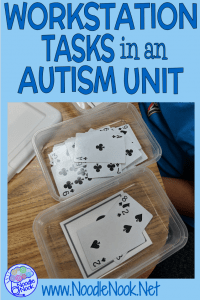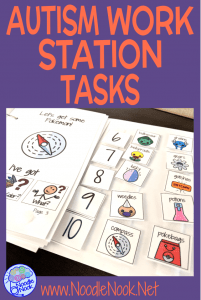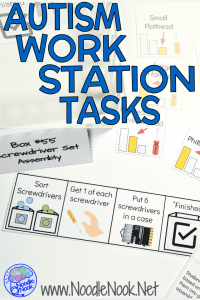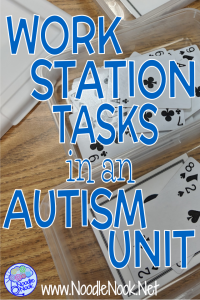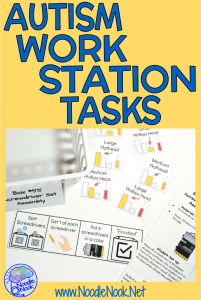The very first year I taught in an Autism Unit I was fresh out of alt-cert and was woefully unprepared for all that you need to be successful teaching students with significant disabilities… what I wouldn’t give to go back to that new teacher with a gaggle of workstation tasks! Unfortunately, time travel is still not for the masses and regrets make no friends. There are several benefits to workstations, tips to make them work, and key ideas to remember as you create task boxes for students that will save you all the toils I went through. If you are just starting out with workstations or task boxes and wondering what will work, here are some things you should know.

Who Started Task Boxes?
The masterminds behind Autism workstation tasks are the folks who invented the TEACCH method or structured teaching from the University of North Carolina-Chapel Hill. TEACCH stands for Treatment and Education of Autistic and Communication related handicapped Children and is evidenced based and researched.
If you are looking to learn more about task boxes and work systems, you can read more on this blog here and here, but you can also learn more by looking for TEACCH method or Structured Learning. Once you have decided task boxes will work for you in your Autism Unit or Special Ed classroom, then here are 7 principles you should follow.
Have a Structured Environment
My grandmother ALWAYS had a clean kitchen. Always. If there was a mess in there, is was not long until she came in and straightened up. I told her one day she should take a rest and let our mess be until tomorrow… her face soured and she said very matter of factly that she couldn’t do what needed to be done in a messy kitchen, so why start tomorrow unprepared?
How do you argue with Gramma knowledge? You can’t. Truth is you can’t do what needs to be done when the environment is working against you. Could you learn to swim in a stand up shower? Could you cook in a bathroom? Could you learn in an environment that is messy, overly sensory, or lacks the supplies you need? No, no and no.
Look around your room… have you set it up in a way that is structured? If you want to learn more about structured classrooms, click here. When you set up your task boxes and work system, you will want to have a structured environment.
Define the Work Space
Cluttered desk means an organized mind? It only sounds good. I have to have a clean desk to work… otherwise I get distracted by all the mess, start cleaning, and never finish what I started in the first place. Having a defined workstation is right up there with structuring the environment. When a student has all their materials at hand, they are able to complete the tasks you lay out for them. The defined space ends up being a visual support for the work, behavior, and skills you are working on. Define that space!
Use Visuals for Support
It has happened more than once… I have asked a teacher what visuals they are using in their classroom and they shrug their shoulders. How? How is a teacher in an Autism Unit of Special Ed classroom NOT using visuals? Don’t make that mistake. Students with Autism typically have a communication related disorder or disability that makes processing oral language and using oral language more difficult. They absolutely need visual supports in place to be successful. When you think about it, we all use visuals all of the time… planners, reminder notes, lists, and signs. Visuals surround us to provide structure and support. Use them for your students to help them be more independent and successful.
Have a Predictable Schedule
Remember back in the good old days when we tuned in to watch broadcast television and you had to wait for your scheduled program to come on. *sigh* My kids will never know what it’s like to wait for Saturday Morning Cartoons because everything in their TV world is on demand.
But I knew… Saturday morning was cartoons. I can actually still tell you what order they came on. And nothing was worse than waking, running to the TV and finding the scheduled had changed for some sports program. SPORTS! Ruined my entire week.
Imagine a student who comes to your class and is always met with the same predictable schedule. There is comfort in that. And the day you change everything is the day they cannot cope. Providing a predictable schedule means you know what you are supposed to do and when. If you operate without one and rely on making things up in the moment, then you heighten a student’s feeling of anxiety and make them less able to learn and be productive.
Put a predictable schedule in place so students can focus on growing, not stressing about what is coming up next.
Use a Visual Schedule
We already talked about visuals, but if you want your Autism unit workstation tasks to be successful, then you need the blend of a predictable schedule and visual support in the form of a visual schedule. You can also use it to define spaces (using visual schedule icons as labels in the classroom) and structure the environment (using a visual schedule icon to define the task at hand).
Just like you have a daily planner or daily to-do list, students in your classroom need a visual schedule to help them use workstations consistently and more independently.
Maximize on Student Strengths
If you are creating independent workstations tasks for students in your Autism Unit or those with significant disabilities, you need to maximize their chances of success with the tasks you use. Choose tasks that maximize on student strengths. The tasks you build for an independent workstation should be ones your student has mastered and can do successfully and consistently. Make good use of their mastered goals by using them in your workstation tasks.
Build Independence
If you do the things listed above, it will support increased independence for your students. BUT it will all be undone if you do not provide a correct level of support in the classroom activities you do. If you are always operating as a level of support above what a student truly needs, then you may be contributing to learned helplessness. Build independence by supporting students the way they need and have a conversation with support staff on how they support students as well.
7 Principles to Using Task Boxes for Autism
Now you know the seven principles to setting up workstation tasks in your Autism workstation and work tasks. Just to recap:
- Have a Structured Environment
- Define the Work Space
- Use Visuals for Support
- Have a Predictable Schedule
- Use a Visual Schedule
- Maximize on Student Strengths
- And Build Independence
Now, go stay strong and teach on!

